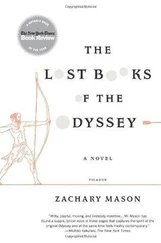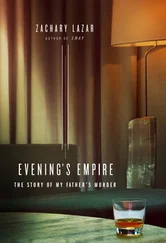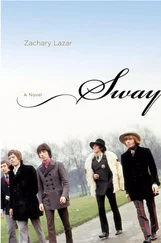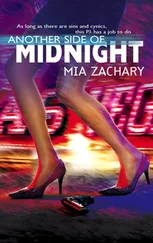I keep driving east.
Around Tulsa, a few fat raindrops hit the windshield. It hadn’t rained in California for months, so now I feel excited. I open the window and breathe in the storm-charged air. All of a sudden, the truck I’m following disappears into a giant waterfall. I barely manage to close the window before I’m deluged. Tons of water splash over the car. It’s like being in a carwash tunnel times ten. I slow down abruptly and keep driving, even though I know the sensible thing to do is just stop and wait for the flood to pass. The wipers race full speed with no effect whatsoever. I’ve never been in such downpour before. I slow down even more. In about twenty minutes the rain subsides a bit and I step on the gas again.
A house appears before my eyes without warning. I hit the brakes and the house disappears. I rub my eyes, grip the steering wheel, and accelerate a little. I see little red flags, then a sign reading OVERSIZED LOAD as I catch up with the house again. It has windows, red curtains, a roof, and a chimney. It looks like a house that has been lived in, not some newly built pre-fab home. It is tied to the back of a truck that is driving extremely slowly. If you can balance a whole house on a truck, I wonder, how hard is it to balance a life in one house? If Stella and I couldn’t do it, such balance is probably impossible. Or it’s only temporary. How long will the house stay on this truck? It can’t stay there forever. Balance, if I have to be loyal to my employers at ICONIQ, is pharmaceutically reversible. They claim that balance is a question of chemistry, and so is imbalance. They say microscopic pheromones, hormones, and still undiscovered chemical compounds rule our behaviors. Being unhappy is an imbalance. Being happy is an imbalance. The balance is probably simply to be.
I crawl behind the house at five miles per hour for a long time before I manage to pass it. I take out the camera and shoot the sky through the windshield, through the wipers, through the sunroof. Somehow, the windshield recalls the format of 35mm film, in which, out of habit, I wait for Stella to appear.
I photograph an Oklahoma washed by the rain and turning gray with the coming winter. At some point, the rain almost completely abates and I find myself in a drier, brighter space. The sky looks higher now, too.
I speed up as I cross the Missouri border. Around Springfield, I see herds of buffalo. The weak, sour gallons of gas station coffee do not wake me much, but they do make me urinate every other hour. The night catches up with me a little short of St. Louis, Missouri (which locals pronounce Muh-zur-ah ). I decide to grab a bite to eat, so I find a roadside restaurant.
In the parking lot in front of it, a row of semis rumble, their engines working 24/7 to maintain both a comfortable temperature in the rig and the size of the hole in the ozone layer. I go inside the place, take a seat and, order a bacon cheeseburger and a Coke. Like it or not, I need to use the toilet, almost as urgently as before the Ramona incident. The design of the American public toilet is the embodiment of discomfort. Its door is cut low at the bottom, so one’s legs are visible to the knees, and also on top, so there are no secrets about what one is doing in there. The American public restroom should not encourage suspicious behavior. This seat is cold and unclean, which is why I experiment with stepping on it and squatting over the opening. Very unpleasant. A second later, with loud belching and nose blowing, two of the drivers come in. One of them barges into the stall to my left and drops down his pants hurriedly; his metal belt-buckle clanks on the tiles. The other one, obviously thinking that my stall is vacant because my feet are invisible, tries the door, which I have thoughtfully locked. Since I did not indicate my presence at the very beginning, I hold my breath and try to remain awkwardly incognito while the following conversation, accompanied by loud plops, takes place:
“. . and she?”
“. . she’s like, leave me alone”
“. . leave her alone?”
“. . she wants me to leave her alone”
“. . and so you?”
“. . and so I’m like, oh, really?!
She goes, yeah, really.”
“A man comes home,
he wants to fuck, right?
What’s the big deal.”
“Yeah, what’s the big deal!”
“Leave her alone, huh?”
What kind of screwed up world is this, I wonder, if men want one thing and women want another? The conversation continues on a less existential topic, then carries on with endless ass wiping, hand washing, coughing, spitting, huffing, and puffing. I wait for them to leave and also exit. Half of the distance to Columbus is behind me. Before me is a night that I must stay awake through.
I enter Indianapolis early in the morning, fill up my tank, and ask for the closest Starbucks. I find it, order a triple espresso, buy a newspaper, and go outside. It’s chilly. A thick army-surplus parka with a homeless man in it is sitting in one of the chairs. His bearded face is covered in big pimples, his hair is disheveled. On the ground next to his muddy boots rests a full black trash bag. I nod and take a seat. He nods back. We are the only ones at the outside tables. On the front page of the paper, there is a map of Southern California stamped with huge fiery letters reading RAGING INFERNO. The wild fires are indicated with little fire symbols in different shades of red (depending on their intensity) — they start at the mountains and crawl down toward the ocean. No one really knows how many of the fires are accidental, how many are the work of arsonists and psychopaths, and how many are simply attempts by ordinary citizens to replace their old houses with new ones using insurance pay-outs. The worst part, I learn from the report, is that the Santa Ana winds are still blowing full speed and are unstoppable.
Despite scientists’ warnings that California would be wiped out by either a mega-tsunami or an earthquake, she is on her way to going down in flames.
I lift my head from the paper and look inside the coffee shop. On the other side of the window, at a small round table, sits a lean, blonde girl in a white shirt and jeans. She is bent over a notebook, writing, occasionally tossing a strand of her hair back, and checking something in the open text book in front of her. In the glass between us, the reflection of the homeless man overlaps with the empty seat next to the girl inside. Semi-transparent, the homeless man finishes up his coffee, leans back comfortably, crosses his legs, and extends a greasy sleeve over the back of the seat as if throwing his arm around the girl.
She doesn’t mind.
He pulls out a Zippo from his torn breast pocket and lights a cigarette.
She sips from her cup without lifting her head from the book.
He blows a cloud of smoke, drops his head back, and scratches his knee.
She fixes her bra strap and keeps writing in her notebook.
There they are — another impossible couple. I take out the Nikon, place it carefully on the table, and take a few shots. A minute later, the girl finishes her coffee, closes the notebook and the textbook, puts them into a leather messenger bag, leans toward her reflection in the glass, adjusts her barrette, slides lipstick over her lips, and smacks them a few times to soften the effect. Then she tosses the bag over her shoulder and walks out. Only the semi-transparent homeless man, who grinds the cigarette butt on the sidewalk with his muddy, untied shoe, remains in the window glass.
*
Stella’s first solo exhibition was a success. There were reviews, articles, a radio show, a few seconds of TV time, a paragraph in Art Globe magazine. There was also a producer who wanted her to be the art director for a music video. There was talk about including her work in a catalog about contemporary American art. The thing about Stella’s paintings, however, was that they seemed as if they were created by different people. Massive squares in rusty browns, which Stella achieved through mixing oils and graphite powder with fine metal particles that she borrowed from the metal shop next door to her studio, had attracted Jane Goldstein to her work. These were non-representational works, save for some atavistic slashes, lines, strokes, and circles. While she was working on them, she would come home as black as a coal-miner and would cough over the sink, spitting out graphite. I convinced her to wear a mask — there was no point in ruining her lungs.
Читать дальше












